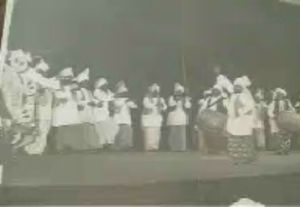
Jhumar
Encyclopedia

Multan
Multan , is a city in the Punjab Province of Pakistan and capital of Multan District. It is located in the southern part of the province on the east bank of the Chenab River, more or less in the geographic centre of the country and about from Islamabad, from Lahore and from Karachi...
and Balochistan
Balochistan (Pakistan)
Balochistan is one of the four provinces or federating units of Pakistan. With an area of 134,051 mi2 or , it is the largest province of Pakistan, constituting approximately 44% of the total land mass of Pakistan. According to the 1998 population census, Balochistan had a population of...
, but thrived specially in Sandalbar
Sandalbar
Sandalbar is a region in Pakistan. The vast tract from Shahdara to Shorkot, Sangla Hill to Toba Tek Singh, is traditionally called Sandalbar. Faisalabad was once part of ancient district Jhang and Sandalbar, a 50-square kilometre part mainly consisted of thick forests and wild tribes. It has been a...
areas of Punjab
Punjab region
The Punjab , also spelled Panjab |water]]s"), is a geographical region straddling the border between Pakistan and India which includes Punjab province in Pakistan and the states of the Punjab, Haryana, Himachal Pradesh, Chandigarh and some northern parts of the National Capital Territory of Delhi...
. It is slower and more rhythmic form of Bhangra. The word "Jhumar" comes from Jhum/Jhoom, which means Swaying. The songs evoke a quality which reminds of swaying. Though the content of these songs is varied - they are usually love with emotional songs too. The Jhumar is a dance of ecstasy .
Jhumar is performed during the harvest season in Punjab. It is a living demonstration of the happiness of men. The dance is mostly performed by the Balochi
Baloch people
The Baloch or Baluch are an ethnic group that belong to the larger Iranian peoples. Baluch people mainly inhabit the Balochistan region and Sistan and Baluchestan Province in the southeast corner of the Iranian plateau in Western Asia....
and Saraiki
Saraiki people
The Saraiki people or Multani people are an ethnic group from the central and south-eastern areas of Pakistan, especially the former princely state of Bahawalpur and the districts of Multan, Lodhran, Vehari, Khanewal, Rahim Yar Khan, Rajanpur, Dera Ghazi Khan, Muzaffargarh,...
people of Southern Punjab.
Any time is Jhumar-time especially during Melas, weddings and other major functions and celebrations. The emphasis of Jhumar is recreating the gaits of animals and birds. The movement of animals, the ploughing of the field, sowing of seeds and harvesting are shown in the original progression. The dance is also performed in circle, to the tune of emotional songs.
The costumes of the dancers are very colorful.
Dancing Style=
Performed exclusively by men, it is a common feature to see three generations - father, son and grandson - dancing all together. The dance is without acrobatics.
The movement of the arms only is considered its main forte. Toes are musically placed in front and backwards and turnings are taken to the right, sometimes the dancers place their one hand below the ribs on the left and gesticulate with the right hand. This dance does not tire out its performers and it is normally danced on moonlight nights in the villages away from the habitation.
The dancers of this dance let-off a sound, "Dee Dee" in tune with the beat of the dance which adds to its grace. This dance has also been integrated into Bhangra.
Types of Jhoomar=
There are three main types of Jhoomar, each of which has a different mood and is therefore suited to different occasionally, reason of its predominating mood. They are:
- Satluj Jhoomar
- Beas Jhoomar
- Chenab Jhoomar
Dancers=
After the Partition of Punjab
Punjab region
The Punjab , also spelled Panjab |water]]s"), is a geographical region straddling the border between Pakistan and India which includes Punjab province in Pakistan and the states of the Punjab, Haryana, Himachal Pradesh, Chandigarh and some northern parts of the National Capital Territory of Delhi...
many dancers moved away and the dance is strapted disappearing, but Phokhar Singh (1916-2002) learned Jhoomar from his uncle and performed it since. Dancing was in his blood.
Before his death he taught the dance to the students at D.A.V. College, Jalalabad, Eastern Punjab
Punjab (India)
Punjab ) is a state in the northwest of the Republic of India, forming part of the larger Punjab region. The state is bordered by the Indian states of Himachal Pradesh to the east, Haryana to the south and southeast and Rajasthan to the southwest as well as the Pakistani province of Punjab to the...
.
External links=

